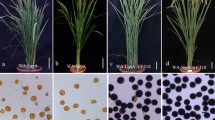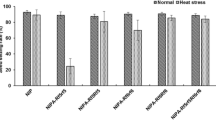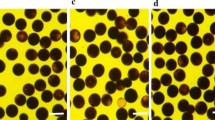Abstract
Wild abortive (WA)-type cytoplasmic male sterility (CMS) has been exclusively used for breeding three-line hybrid indica rice, but it has not been applied for generating japonica hybrids because of the difficulties related to breeding japonica restorer lines. Determining whether the major restorer-of-fertility (Rf) gene used for indica hybrids can efficiently restore the fertility of WA-type japonica CMS lines may be useful for breeding WA-type japonica restorer lines. In this study, japonica restorer lines for Chinsurah Boro II (BT)-type CMS exhibited varying abilities to restore the fertility of ‘WA-LiuqianxinA’, which is a WA-type japonica CMS line. Additionally, Rf genes for WA-type CMS were identified in the BT-type japonica restorers. Meanwhile, ‘C9083’, which is a BT-type japonica restorer, exhibited a limited ability to restore the fertility of WA-type japonica CMS lines, and a genetic analysis revealed that the fertility restoration was controlled by one locus. The Rf gene was mapped to an approximately 370-kb physical region and was identified as Rf4. Furthermore, Rf gene dosage effects and the temperature influenced the fertility restoration of WA-type japonica CMS lines. This study is the first to confirm that Rf4 has only minor effects on the fertility restoration of WA-type japonica CMS lines. These results may be relevant for the development of WA-type japonica hybrids.





Similar content being viewed by others
References
Ahmadikhah A, Karlov GI (2006) Molecular mapping of the fertility-restoration gene Rf4 for WA-cytoplasmic malesterility in rice. Plant Breed 125:363–367
Akagi H, Yokozeki Y, Inagaki A, Nakamura A, Fujimura T (1996) A codominant DNA marker closely linked to the rice nuclear restorer gene, Rf1, identified with inter-SSR fingerprinting. Genome 39:1205–1209
Barclay A (2010) Hybridizing the world. Rice Today 9:32–35
Cai J, Liao QP, Dai ZJ, Zhu HT, Zeng YF, Zhang ZM, Zhang GQ (2013) Allelic differentiations and effects of the Rf3 and Rf4 genes on fertility restoration in rice with wild abortive cytoplasmic male sterility. Biol Plant 52:274–280
Chen LT, Liu YG (2014) Male sterility and fertility restoration in crops. Annu Rev Plant Biol 65:579–606
Cheng SH, Zhuang JY, Fan YY, Du JH, Cao LY (2007) Progress in research and development on hybrid rice: a super-domesticate in China. Ann Bot 100:959–966
Fujii S, Toriyama K (2009) Suppressed expression of retrograde-regulated male sterility restores pollen fertility in cytoplasmic male sterile rice plants. Proc Natl Acad Sci USA 106:9513–9518
Fujimura T, Akagi H, Oka M, Nakamura A, Sawada R (1996) Establishment of a rice protoplast culture and application of an asymmetric protoplast fusion technique to hybrid rice breeding. Plant Tissue Cult Lett 13:243–247
Hu J, Wang K, Huang WC, Liu G, Gao Y, Wang JM, Huang Q, Ji YX, Qin XJ, Wan L, Zhu RS, Li SQ, Yang DC, Zhu YG (2012) The rice pentatricopeptide repeat protein RF5 restores fertility in Hong-Lian cytoplasmic male-sterile lines via a complex with the glycine-rich protein GRP162. Plant Cell 24:109–122
Huang RH (1997) Effect of different environmental factors on male-fertility stability of Longtepu A CMS lines. Fujian Sci Technol Rice Wheat 15:13–18
Huang JZ, E ZG, Zhang HL, Shu QY (2014) Workable male sterility systems for hybrid rice: genetics, biochemistry, molecular biology, and utilization. Rice 7:13
Huang QY, He YQ, Jing RC, Zhu RS, Zhu YG (2000) Mapping of the nuclear fertility restorer gene for HL cytoplasmic male sterility in rice using microsatellite markers. Chin Sci Bull 45:430–432
Huang WC, Hu J, Yu CC, Huang Q, Wan L, Wang LL, Qin XJ, Ji YX, Zhu RS, Li SQ, Zhu YG (2012) Two non-allelic nuclear genes restore fertility in a gametophytic pattern and enhance abiotic stress tolerance in the hybrid rice plant. Theor Appl Genet 124:799–807
Huang WC, Yu CC, Hu J, Wang LL, Dan ZW, Zhou W, He CL, Zeng YF, Yao GX, Qi JZ, Zhang ZH, Zhu RS, Chen XF, Zhu YG (2015) Pentatricopeptide-repeat family protein RF6 functions with hexokinase 6 to rescue rice cytoplasmic male sterility. Proc Natl Acad Sci USA 112:14984–14989
Itabashi E, Iwata N, Fujii S, Kazama T, Toriyama K (2011) The fertility restorer gene, Rf2, for Lead Rice-type cytoplasmic male sterility of rice encodes a mitochondrial glycine-rich protein. Plant J 65:359–367
Kazama T, Toriyama K (2014) A fertility restorer gene, Rf4, widely used for hybrid rice breeding encodes a pentatricopeptide repeat protein. Rice 7:28
Komori T, Ohta S, Murai NY, Kuraya Y, Suzuki S, Hiei Y (2004) Map-based cloning of a fertility restorer gene, Rf-1, in rice (Oryza sativa L.). Plant J 37:315–325
Li SQ, Yang DC, Zhu YG (2007) Characterization and use of male sterility in hybrid rice breeding. J Integr Plant Biol 49:791–804
Lincoln S, Daly M, Lander E (1992) Constructing genetic maps with MAPMAKER/EXP 3.0. Whitehead Institute Technical Report, Whitehead Institute, Cambridge
Livak KJ, Schmittgen TD (2001) Analysis of relative gene expression data using real-time quantitative PCR and the 2(-Delta Delta C(T)) Method. Methods 25:402–408
Luo DP, Xu H, Liu ZL, Guo JX, Li HY, Chen LT, Fang C, Zhang QY, Bai M, Yao N, Wu H, Ji CH, Zheng HQ, Chen YL, Ye S, Li XY, Zhao XC, Li RQ, Liu YG (2013) A detrimental mitochondrial-nuclear interaction causes cytoplasmic male sterility in rice. Nat Genet 45:573–577
Rogers SO, Bendich AJ (1985) Extraction of DNA from milligram amounts of fresh, herbarium and mummified plant tissues. Plant Mol Biol 5:69–76
Tang SZ, Zhang HG, Liang GH, Yan CJ, Liu QQ, Gu MH (2008) Reasons and countermeasures of slow development on Three-line Japonica hybrid rice. Hybrid Rice 23:1–5
Tang HW, Luo DP, Zhou DG, Zhang QY, Tian DS, Zheng XM, Chen LT, Liu YG (2014) The rice restorer Rf4 for wild-abortive cytoplasmic male sterility encodes a mitochondrial-localized PPR protein that functions in reduction of WA352 transcripts. Mol Plant 7:1497–1500
Wang ZH, Zou YJ, Li XY, Zhang QY, Chen LT, Wu H, Su DH, Chen YL, Guo JX, Luo D, Long YM, Zhong Y, Liu YG (2006) Cytoplasmic male sterility of rice with boro II cytoplasm is caused by a cytotoxic peptide and is restored by two related PPR motif genes via distinct modes of mRNA silencing. Plant Cell 18:676–687
Yang ZY (1994) Progresses in the breeding of japonica hybrid rice. Hybrid Rice 1994(z1):46–49
Yang ZY, Li ZB, Dong L, Zhu W, Cai Z, Qu LJ, Hua ZT (2016) Development and prospect of hybrid japonica rice in China. Chin Sci Bull 61:3770–3777
Yuan LP (1994) Increasing yield potential in rice by exploitation of heterosis. In: Virmanni SS (ed) Hybrid rice technology. New developments and future prospects. IRRI, Manila, pp 1–6
Zhang G, Lu Y, Bharaj TS, Virmani SS, Huang N (1997) Mapping of the Rf-3 nuclear fertility-restoring gene for WA cytoplasmic male sterility in rice using RAPD and RFLP markers. Theor Appl Genet 94:27–33
Zhang QY, Liu YG, Zhang GQ, Mei MT (2002) Molecular mapping of the fertility restorer gene Rf-4 for WA cytoplasmic male sterility in rice. Acta Genetica Sinica 29:1001–1004
Acknowledgements
This study was financially supported by the National Key Research and Development Program (2016YFD0101107), the National Basic Research Program of China (2013CBA01405), and the Priority Academic Program Development of Jiangsu Higher Education Institutions. We thank Lesley Benyon, PhD, from Liwen Bianji, Edanz Group China (www.liwenbianji.cn/ac), for editing the English text of a draft of this manuscript.
Author information
Authors and Affiliations
Contributions
HZ analyzed the data and drafted the manuscript. XC and LZ evaluated the phenotypes and analyzed the data. HS and YG helped construct the BC population. MG helped design the study. ST designed the study and revised the manuscript. All authors read and approved the final manuscript.
Corresponding author
Ethics declarations
Conflict of interest
The authors declare that they have no conflict of interest.
Electronic supplementary material
Below is the link to the electronic supplementary material.
Rights and permissions
About this article
Cite this article
Zhang, H., Cheng, X., Zhang, L. et al. Rf4 has minor effects on the fertility restoration of wild abortive-type cytoplasmic male sterile japonica (Oryza sativa) lines. Euphytica 214, 49 (2018). https://doi.org/10.1007/s10681-018-2128-0
Received:
Accepted:
Published:
DOI: https://doi.org/10.1007/s10681-018-2128-0




